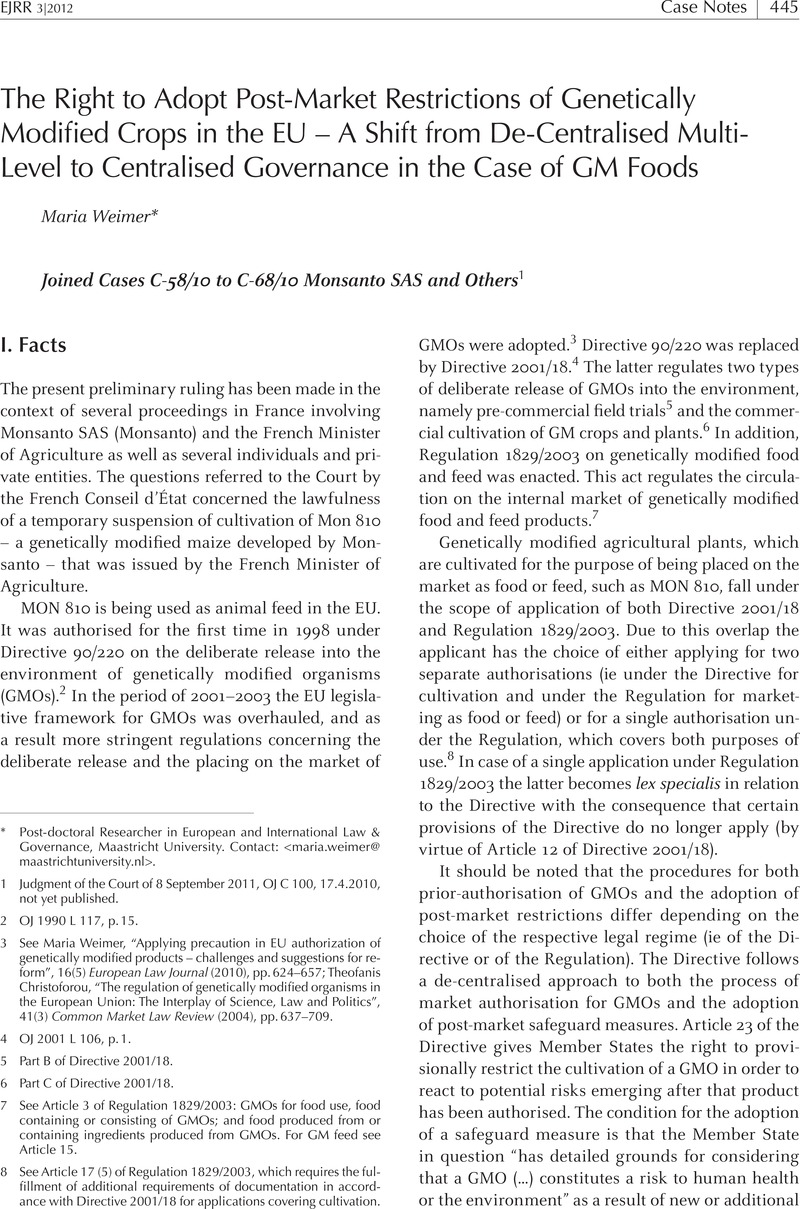Published online by Cambridge University Press: 20 January 2017

1 Judgment of the Court of 8 September 2011, OJ C 100, 17.4.2010, not yet published.
2 OJ 1990 L 117, p. 15.
3 See Weimer, Maria, “Applying precaution in EU authorization of genetically modified products – challenges and suggestions for reform”, 16(5) European Law Journal (2010), pp. 624–657 CrossRefGoogle Scholar; Christoforou, Theofanis, “The regulation of genetically modified organisms in the European Union: The Interplay of Science, Law and Politics”, 41(3) Common Market Law Review (2004), pp.637–709 Google Scholar.
4 OJ 2001 L 106, p. 1.
5 Part B of Directive 2001/18.
6 Part C of Directive 2001/18.
7 See Article 3 of Regulation 1829/2003: GMOs for food use, food containing or consisting of GMOs; and food produced from or containing ingredients produced from GMOs. For GM feed see Article 15.
8 See Article 17 (5) of Regulation 1829/2003, which requires the fulfillment of additional requirements of documentation in accordance with Directive 2001/18 for applications covering cultivation.
9 Namely to Articles 53 – 54 of Regulation 178/2002.
10 In fact, the French authorities have issued a series of consecutive orders within the period of three months, all of which aimed at restricting the cultivation of MON 810. For the sake of simplification this report summarizes them as one temporary suspension.
11 Para 57–58.
12 Para 58–63.
13 Para. 66.
14 This would have been important for the right of Member States to adopt emergency measures insofar as Article 53 of Regulation 178/2002 provides as a condition for the Commission to act that the risk cannot be contained satisfactory by means of measures taken by the Member States. It thus makes the action of the Commission subsidiary to the action of the Member States under Regulation 178/2002. See on that Opinion of AG Mengozzi, para. 49.
15 Para. 69.
16 Para. 70.
17 See Opinion of AG Mengozzi, para. 53.
18 Para. 75.
19 Para. 76.
20 Para. 77.
21 Para. 78.
22 Para. 79.
23 Para. 80.
24 Para. 81.
25 See Case C-6/99 Greenpeace France and Others [2000] ECR I-1651; Case C-236/01 Monsanto Agricoltura Italia and Others [2003] ECR I-8105; Joined Cases T-366/03 and T-235/04 Land Oberösterreich and Republic of Austria v Commission [2005] ECR II-04005 and Joined Cases C-439/05 P and C-454/05 P Land Oberösterreich and Republic of Austria v Commission [2007] ECR I-07141; Case C-165/08 Commission v Republic of Poland [2009] ECR I-06843.
26 For primary law Article 114 (5) of the TFEU; for secondary law: legal clauses contained in EU legislation on GMOs, see below in this case-note.
27 See AG Mengozzi, para. 1.
28 See para.30 where the AG states: “I note that, from a legal standpoint, the core issue in the main proceedings appears to consist in determining the scope of Article 12 of Directive 2001/18.”
29 Para. 36.
30 See for example the different procedures of notification and prior-authorisation for different substances under the REACH legal framework for the regulation of chemicals.
31 See in this sense also AG, para. 40.
32 There are currently six Member States who have suspended the use of MON 810 using the legal basis of Article 23 of Directive 2001/18.
33 See AG opinion para. 42.
34 This approach is still being maintained in several legal acts of Union law, such as for example the Novel Foods Regulation and the REACH Regulation. However, seeing the problems for the internal market experienced with the use of safeguard-clauses by the Member States legal changes can be expected in the future.
35 See Dabrowska, Patrycja, “EU Governance of GMOs: Political Struggles and Experimentalist Solutions?”, in Sabel, Charles F. and Zeitlin, Jonathan (eds), Experimentalist Governance in the European Union (Oxford; New York: Oxford University Press, 2010)Google Scholar; Lee, Maria, EU Regulation of GMOs: Law and Decision Making for a new Technology (Cheltenham, UK: Northhampton, MA: Edward Elgar, 2008)CrossRefGoogle Scholar.
36 See on this Weimer, Maria, “What Price Flexibility? The recent Commission Proposal to allow for national ‘opt-outs’ on GMO cultivation under the Deliberate Release Directive and the Comitology reform post-Lisbon”, 1(4) European Journal of Risk Regulation (2010), pp. 345–352 CrossRefGoogle Scholar; Zurek, Karolina, “Indicating Reasons for National GM ‘Opt-outs’”, 2(2) European Journal of Risk Regulation (2011), pp.241–244 CrossRefGoogle Scholar.
37 See critical voices among German scholars: Winter, NVwZ 2005, pp. 1133–1136; Roller, Zeitschrift für Umweltrecht 2005, pp.113– 117.
38 But also in other pieces of EU legislation, such as the Novel Foods Regulation and the REACH Regulation.
39 In Monsanto Italia Agricoltura the Court when interpreting the safeguard clause of Regulation 257/97 (Novel Foods Regulation) stated that protective measures may be taken pursuant a safeguard clause interpreted in the light of the precautionary principle “even if it proves impossible to carry out as full a risk assessment as possible in the particular circumstances of a given case because of the inadequate nature of the available scientific data.” See para 112 of the judgement.
40 Rather the principle was mentioned under the second question in order to argue the necessity of urgent action on the part of Member State in the sense of immediate communication of the adoption of emergency measures to the Commission, see para. 71 of the judgment.
41 See for an overview Asselt, Marjolein Van and Renn, Ortwin, “Risk Governance”, 4(4) Journal of Risk Research, pp.431–449 Google Scholar and Everson, Michelle & Vos, Ellen (eds), Uncertain Risks Regulated, (London: Routledge-Cavendish, 2009)Google Scholar.
42 Van Asselt and Renn, “Risk Governance”, supra note 41; Wynne, Brian, “Uncertainty and Environmental Learning”, 2 Global Environmental Change (1992), pp.111–127 CrossRefGoogle Scholar.
43 See AG's legal opinion, para. 71: “in order to adopt emergency measures relating to genetically modified organisms pursuant to Article 34 of the regulation, it is necessary for the existence of a risk to human health, animal health, or the environment to be established, which is not merely hypothetical, and for the probability of such harm occurring to be significant, even though it has not necessarily been determined precisely.”